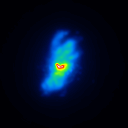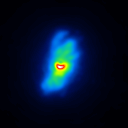 |  |
This document describes a series of tests which uses computer simulated data to evaluate the performance of the LINC-NIRVANA Data Reduction Software (LN DRS). Each test focuses on an instrument/observation specific aspect regarding the data which are later on available for the reconstruction task. In addition possible actions are described which assist in dealing with some raw data properties.
Each test section is split in a short description of the purpose of the test, a detailed specification of the setup, a list of the simulated input data, a presentation of the reconstruction results, and a short discussion of recommended actions (optional)
All test described in this document follow a common scheme which includes:
Since the LINC-NIRVANA Data Reduction Software implements an instrument specific pipeline, all test share a common setup (see table 1).
| Parameter | Description |
|---|---|
| Detector | A HAWAII-2 FPA with a pixel size of 18 micron, a quantum efficiency of 60 percent, a readout noise of 11 electrons, the size was set to 512x512 pixels. |
| Telescope | The telescope is the LBT with a primary mirror size of 8.4m (central hole of 1m), a center to center distance of 14.4m and the focal ratio of the telescope/instrument is 32.5. |
| Atmosphere/AO | The used combined transmission of the atmosphere, telescope, and instrument is 50 percent. The turbulence cell size was set to 0.6m (J-Band) and 1.2m (K-Band), the coherence time to 100ms (about 0.3 arcsec seeing). |
| Observation | The sky background is 16mag/arcsec2 for the J-band and 13mag/arcsec2 for the K-band (like Paranal). The observation target is NGC4151 with an overlayed dust torus (simulated) at 10.1mag integral brightness. The second target is a small star cluster, their positions and brightness are described in table 2. For each position angle (108, 144, 180, 216, 252 degree) an image equivalent to 60s exposure time was created. The wavelength was 1.165 - 1.325 micron (J-Band) and 2.0 - 2.4 micron (K-band). For some experiments concerning the atmospheric dispersion, only the shorter half of the J-Band was used (1.156 - 1.250 micron). |
| Reconstruction | For the reconstruction step an IDL implementation of the Richardson-Lucy algorithm with 20000 iterations was used. |
| Brightness [mag] | Position [px] |
|---|---|
| 19.00 | 256, 256 |
| 19.40 | 268, 266 |
| 19.75 | 272, 265 |
| 22.50 | 254, 240 |
| 19.00 | 214, 286 |
| 19.40 | 212, 285 |
| 22.25 | 215, 290 |
| 22.50 | 236, 210 |
| 22.25 | 282, 209 |
| 22.50 | 285, 207 |
| 19.75 | 200, 245 |
| 23.50 | 250, 300 |
The raw data for all tests were generated with a set of C-programs and a Bash-script. This Bash-script additionally generates the parameter files which are later used by the LN DRS pipeline implemented in IDL. The principle steps for generating the input raw data files used by the pipeline are:
The basis of the simulations is an image of NGC4151 with an overlayed dust torus and a small star cluster. In figure 1 and figure 2 the images in J-Band and K-Band, convolved with the ideal 22.8m telescope psf are shown.
 |  |
 |  |
For some tests, the images for the target and calibrator are generated separately and sometimes later combined before the poisson noise is applied.
In the section discussing the reconstruction results, an error measurement is used which calculates the global difference between the ideal image and a reconstruction convolved with the ideal psf (both 23m psf). This measurement is described in the paper "K-H. Hofmann, T. Driebe, M. Heininger, D. Schertl and G. Weigelt, 2005, A&A, 444, 983-993".
A list of all test described in this document is given in table 3
| Number | Section | Short description |
|---|---|---|
| 1 | section Dependency on the calibrator brightness | This test investigates the quality of the reconstruction depending on the calibrator brightness. |
| 2 | section Dependency on the strehl deviation | This test investigates the case, where the strehl of the target is different to the strehl of the psf star. |
| 3 | section Dependency on the FFTS performance | This test investigates the dependency on the FFTS phase errors, where the same phase error jitter is used for the target and calibrator PSF. |
| 4 | section Dependency on the OPD error | This test investigates the dependency on the FFTS phase errors, where different mean and standard deviation are used for the target and calibrator PSFs. |
| 5 | section Dependency on the beam overlap | This test investigates the dependency on overlap errors, where a fixed offset and a statistical jitter of the beam position is simulated. |
| 6 | section Dependency on the target and calibrator spectrum | This test investigates the dependency of the reconstruction error on the target and calibrator spectrum. |
| 7 | section Dependency on the atmospheric dispersion | This test investigates the dependency of the reconstruction error on the atmospheric dispersion. |
| 8 | section Dependency on the atmospheric dispersion and target and calibrator spectrum | This test investigates the dependency of the reconstruction error on the atmospheric dispersion and target and calibrator spectrum. |
| 9 | section Dependency on the differences in the target and calibrator altitude | This test investigates the dependency of the reconstruction error on the differences in the target and calibrator altitude. |
| 10 | section Using an artificial psf for the deconvolution | This test investigates the dependency of the reconstruction error on the PSF creation method. |
| 11 | section Using an artificial psf for the deconvolution | This test investigates the dependency of the reconstruction error on the PSF creation method. |